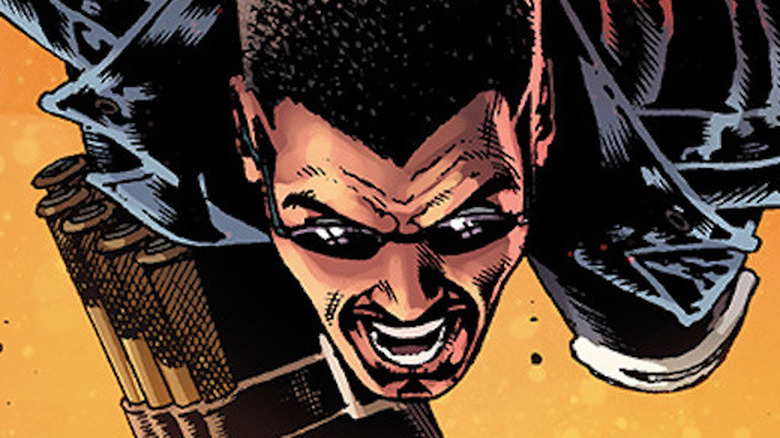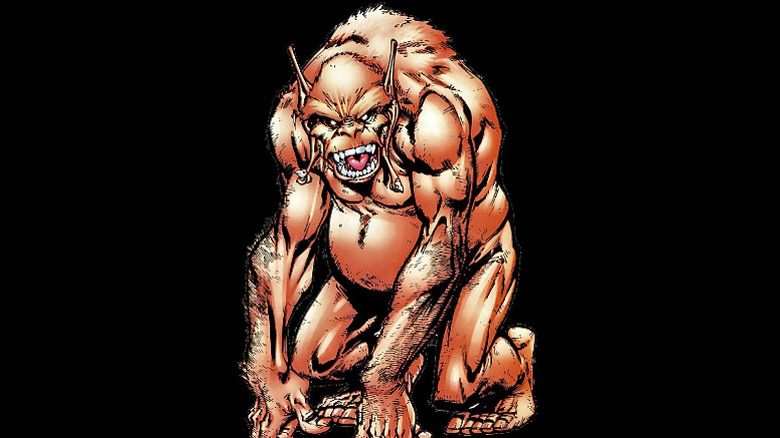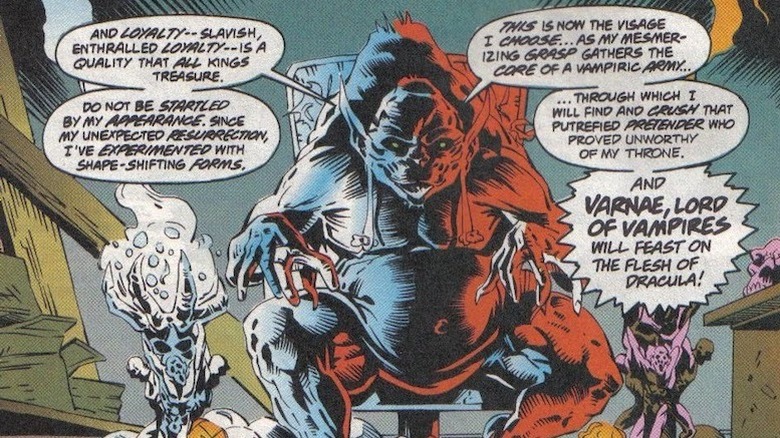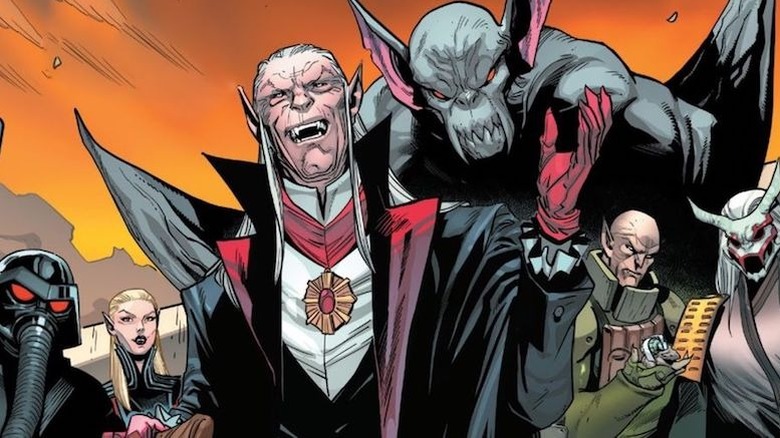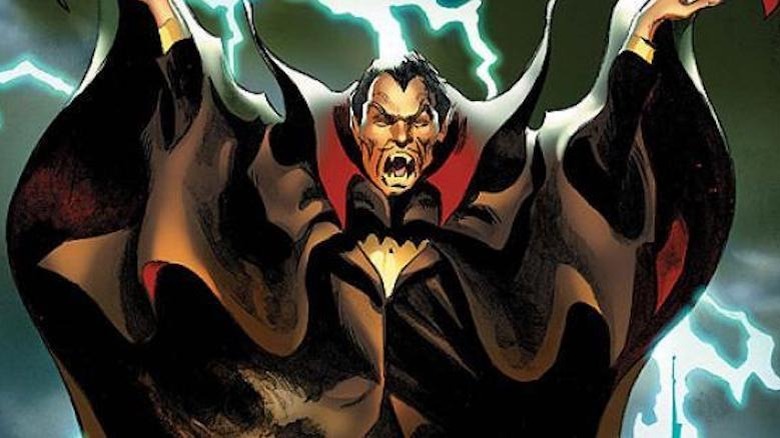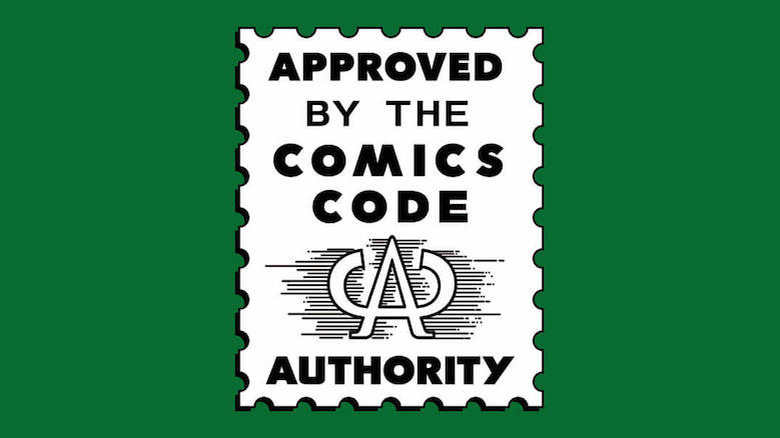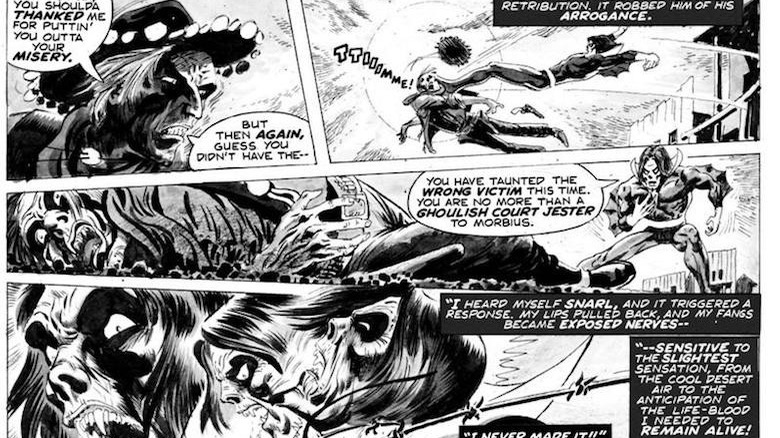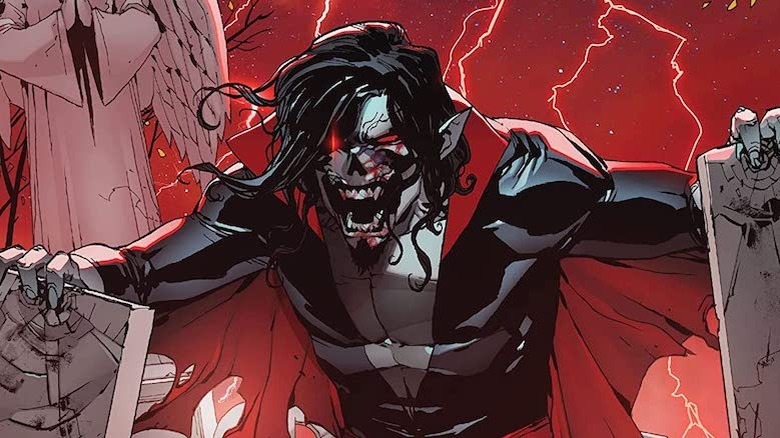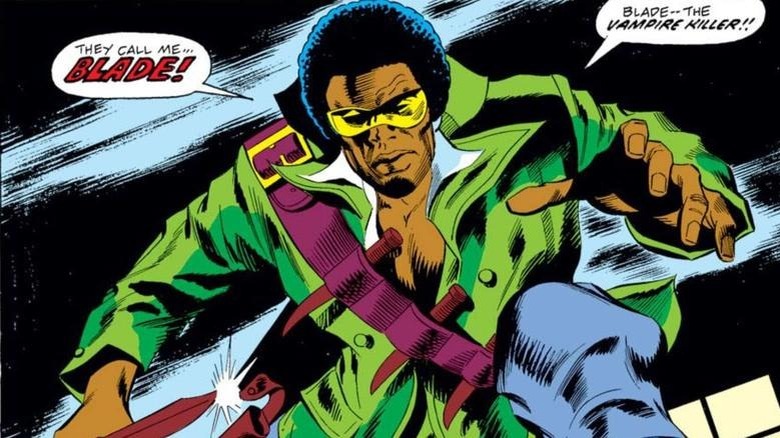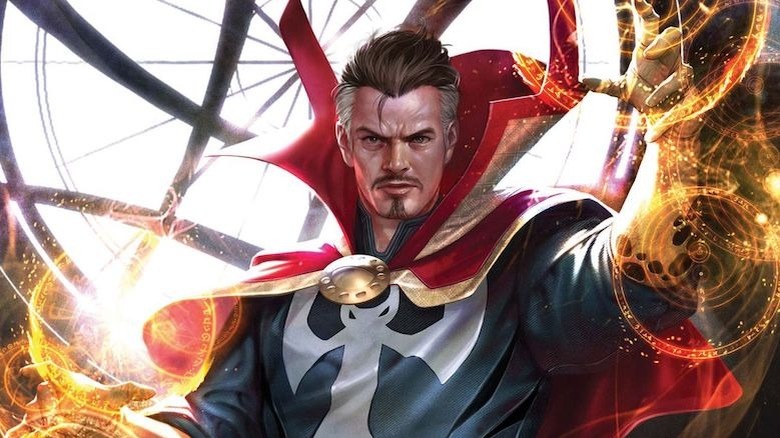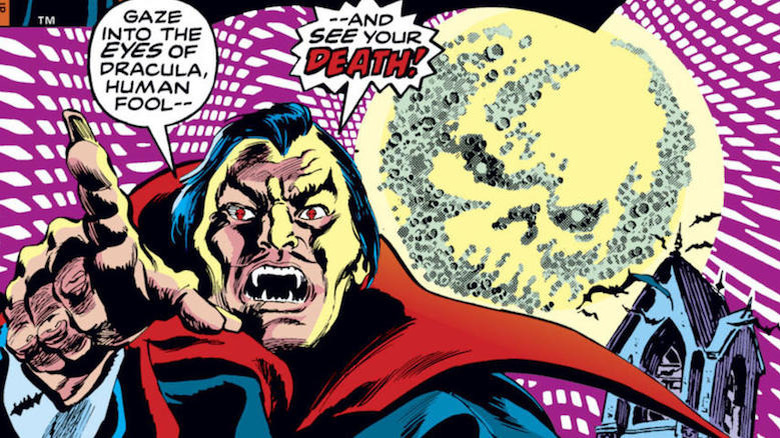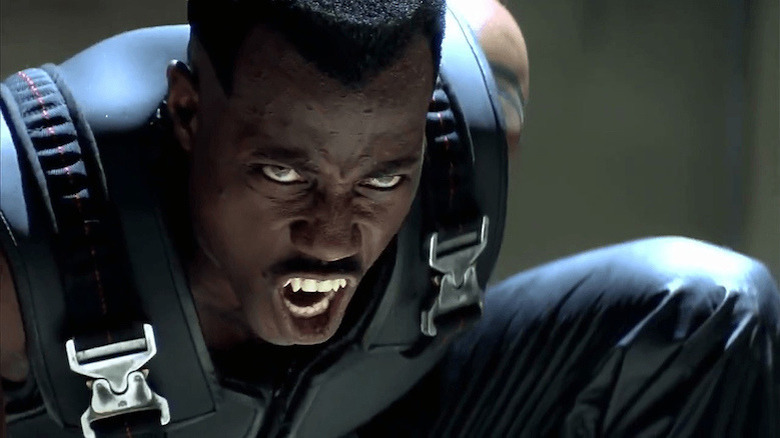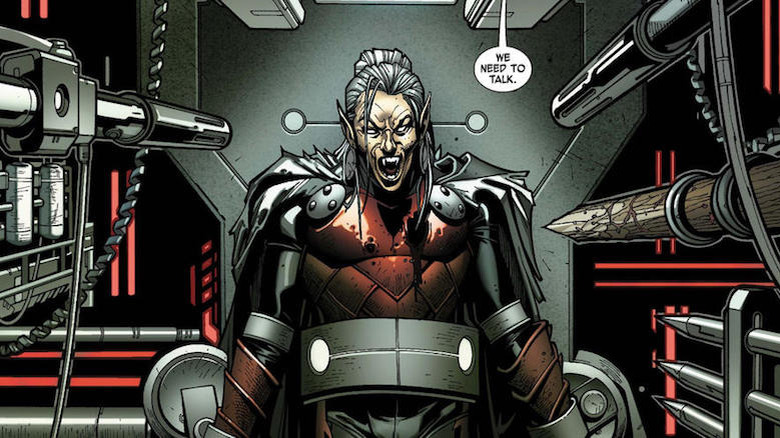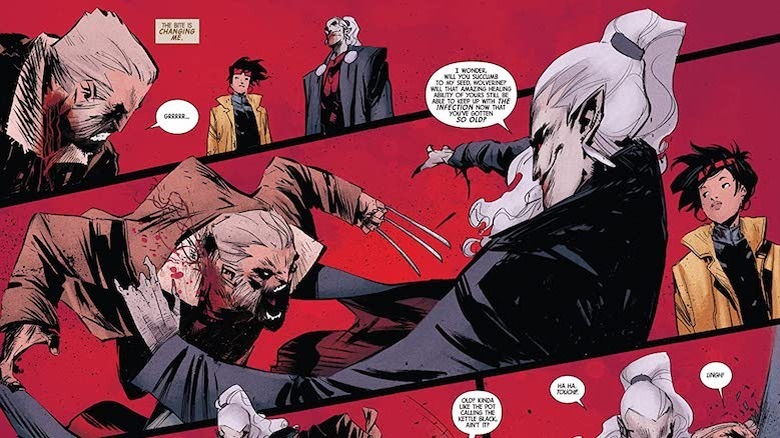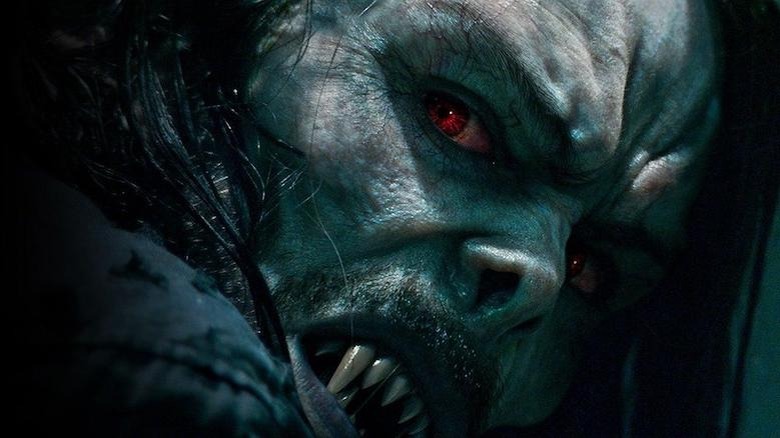The History Of Marvel Vampires Explained
Marvel's roster of heroes and villains features no shortage of costumed vigilantes and over-the-top bad guys, but the more horror-tinged stories from "The House of Ideas" also includes those iconic bloodsuckers, vampires. The first modern Marvel cinematic hit, 1998's "Blade," followed the titular Daywalker as he fought against the undead scourge, but the history of vampires in Marvel comics dates back to long before Blade's 1973 print debut.
Vampires first appeared in the pages of "Marvel Mystery Comics" #35, published by Timely Comics in 1942. Timely would eventually evolve into Marvel, which makes this little-known story the proper debut of Marvel's version of vampires. In terms of lore, however, Marvel vampires date back thousands of years, and include icons like Varnae and the immortal legend himself, Dracula. From repression by the Comics Code Authority to clashes with the X-Men, this is the history of vampires in the Marvel Universe.
Cultists used the Darkhold to create the first vampire
Varnae's origins are covered in 1991's "Conan the Barbarian" #245 and 1989's "Doctor Strange: Sorcerer Supreme" Volume 1 #11, which included a tale about the Darkhold, the Marvel universe's ultimate tome of black magic. The story, called "The Book of the Vishanti: The Curse of the Darkhold Part III – Dawn of Blood" explains Varnae's origins as the first vampire. Part of an Atlantean cult loyal to Thulsa Doom, Varnae was mortally wounded by Kull of Atlantis until his life was saved by the Darkhold's magic, but it also transformed him into the world's first vampire. In his new form, Varnae fancied himself a ruler, and attempted to take over Atlantis until the city was destroyed.
While Varnae is an original Marvel creation, he takes his name from the story "Varney the Vampire," a penny dreadful serial that was published as a novel in 1847.
Varnae spent centuries attacking humanity
After the fall of Atlantis, Varnae spent millennia as the de facto leader of the vampire race, and tried multiple times to encroach on the realm of man. He was known by many names, such as the demon Baal and Tsathoggua, a name that comes from one of author H.P. Lovecraft's "Great Old Ones." Native Americans knew him as Croatoan, linking the vampire to the mysterious disappearance of the lost colony of Roanoke.
In Varnae's appearance in the pages of "Conan the Barbarian" #245, the original vampire led an attack on humanity, but was repelled by the combined might of Conan, Red Sonja, and Zula. Likewise, in the story "Norse Blood" found in the pages of "Marvel Comics Presents" Volume 1 #63, Varnae set his sights on a colony of Vikings in North America, circa 1000 A.D., but was defeated by none other than the God of Thunder, Thor Odinson.
Different types of vampires all come from Varnae
All vampires come from Varnae, either from his bite or the bite of one of his victims/converts, but not all vampires are the same. In 2010, for the sake of consistent storytelling, the "Curse of the Mutants" storyline (which will be covered in greater detail a bit later on) established a variety of vampire sects — different groups of bloodsucking undead with different physical traits and special powers.
Across the world, there are many different Vampire sects, from the classic-style Dracula derivatives to more monstrous ghouls akin to Count Orlok of "Nosferatu." Some sects deal with magic and get stronger based on how much or how little blood they consume, while still others feed on less powerful vampire sects. "Curse of the Mutants" effectively covered its bases by setting up all the different types of vampires, allowing for future writers to act within this new status quo or, if Marvel's editors allow it, introduce new sects to shake things up for future storytelling possibilities.
The rise of Vlad Dracula
In real life, Vlad Tepes, better known as Vlad the Impaler, served as the inspiration for Count Dracula, the literary icon created by Bram Stoker in his novel "Dracula." In the Marvel universe, a man named Vlad Tepes Dracula was chosen by Varnae to be the next ruler of the vampire race. As explained in the "Tomb of Dracula" series, Vlad was born in Transylvania (now known as Romania) and became a military leader, loosely based on the real Tepes, before being bitten by a vampire and becoming one himself.
All along, Varnae was behind Dracula's transformation, secretly influencing events to test the young vampire and make him stronger. In 1973's "Dracula" #3, Varnae pits Dracula against his lieutenant, Nimrod, with Dracula emerging victorious. After more tests, a pleased Varnae gives his blood to Dracula, granting him unparalleled vampire strength. Varnae then commits suicide via sunlight and leaves the immortal Dracula as the new ruler of the vampire race.
Vampires were forbidden by the Comics Code Authority until the 1970s
Characters like Varnae and Dracula were not properly introduced into the Marvel universe until the 1970s, though vampires made sporadic appearances in the horror comics of the 1940s. This is due to the meddling of the Comics Code Authority (CCA), a censorship board that kept most comics squeaky clean and safe for even the most fragile children ... or rather, their overly protective parents.
Big publishers like Marvel and DC strictly followed the rules of the CCA starting in the mid 1950s. However, in 1971, Marvel openly defied the CCA by printing "Green Goblin Reborn!," a Spider-Man series featuring a storyline about drug addiction. It helped that Stan Lee was asked directly by the U.S. Department of Health to do a story about the dangers of drug addiction. Immediately prior to this, the CCA began to relax its policies on monsters, allowing certain undead creatures to appear in the family-friendly pages of Marvel Comics, including vampires, which led to the creation of characters like Morbius, Blade, and Vlad Dracula. As a result, the CCA's power over mainstream comics began to wane, leading to more topical, political, and violent stories in the years to come.
Vampire Tales Magazine
One way Marvel got around the rules of the Comics Code Authority was through affiliated publications like "Vampire Tales." This was a magazine, not a comic book, and thus not subject to the CCA's regulations. The black-and-white stories printed in "Vampire Tales" were allowed to feature more blood, profanity, and sexual content than anything in a typical Marvel comic.
"Vampire Tales" featured stories starring Dracula, Morbius, Blade, and others, as well as horror stories that pre-dated the CCA and thus could not be reprinted in a typical comic. The magazine only lasted 11 issues between 1973 and 1975, but the book's darker tone and more graphic content was a hint of things to come for Marvel. During these years, the publisher would introduce more hard-edged anti-heroes like Wolverine and the Punisher, characters whose stories would feature more brutal themes than anything they tackled in the 1960s.
Morbius the Living Vampire
In the wake of the CCA loosening restrictions on vampires, Roy Thomas and Gil Kane created a new Spider-Man villain: Morbius, the Living Vampire. Unlike traditional vampires who are descended from Varnae and the Darkhold's magic, Dr. Michael Morbius is an "artificial" vampire. Ever since childhood, Morbius suffered from a rare blood disease, so he became a scientist in an effort to cure himself. Unfortunately, his experimental treatment gives him vampire-like abilities, including flight, super-strength, and a healing factor. Unfortunately, he also developed an unquenchable thirst for blood and his face mutated to resemble that of a pale bat.
Rather than a straight villain, Morbius is often portrayed as a tragic figure who does bad things but can't control himself and seeks a cure for what ails him, not unlike Bruce Banner, a.k.a. the Incredible Hulk. He's fought against and alongside Spider-Man several times, at one point (in 1980's "Peter Parker, the Spectacular Spider-Man" #38) even using his "radioactive spider blood" to create a serum that would temporarily restore his humanity and cure him of his bloodlust.
Blade the Vampire Slayer
The most famous vampire hunter this side of Buffy and Van Helsing, Eric Brooks, a.k.a. Blade, made his Marvel debut in the pages of 1973's "Tomb of Dracula" #10. His pregnant mother was attacked by the vampire Deacon Frost, whose attack transferred a defense against vampirism to the baby Blade as he was born. Armed with an immunity to vampire bites and an unparalleled hatred towards the monsters that murdered his mother during childbirth, Blade studied martial arts under Jamal Afari. When Afari was killed by Dracula, Blade's hatred for the vampire race only increased.
In the wake of the "Blade" trilogy of films, which reimagined the character as possessing more vampiric traits including superhuman strength, the comic version was tweaked; following a bite from Morbius, Blade developed superhuman abilities, essentially putting the comic book version of the character in line with the iconic Wesley Snipes cinematic incarnation.
Doctor Strange and his vampire genocide
Despite his physical power and assorted vampire abilities, Dracula's greatest strength is his immortality. Upon being killed, he could simply resurrect, even if dismembered or reduced to ash. In the pages of "Doctor Strange" Vol. 2, #58-61, published in 1983, the Sorcerer Supreme attempts to take down the vampire scourge for good using the Montesi Formula, which also serves as the name of the trade paperback that collected the issues in a single book.
The story features Strange working alongside Blade, Hannibal King, and Dracula's heroic descendent, Frank Drake. It ends with the sorcerer using the Montesi Formula, a spell hidden within the Darkhold, to destroy all vampires. Doctor Strange's vampire genocide succeeds for a time, but the spell eventually wears off and Dracula returns yet again, in 1987's "Avengers Annual" #16. Ironically, it would later be revealed that Doctor Strange secretly had a brother, Victor, who had been transformed into a vampire by Strange's reckless usage of the Book of the Vishanti, the white magic counterpart to the Darkhold.
The return of Dracula and Varnae
In the years following Doctor Strange's use of the Montesi Formula and Dracula's inevitable resurrection, vampires began to reemerge as a threat, fighting against the Nightstalkers, a team consisting of Blade, Hannibal King, and Frank Drake, all working together under the watchful eye of Doctor Strange. The short-lived title's final three issues, #16-18, published in 1994, served as something of a bittersweet epilogue to the "Tomb of Dracula" run from the 1970s.
The story explains that the Montesi Formula spell is wearing off and that the Nightstalkers need to be prepared to fight Dracula again. Instead of Dracula, however, they are confronted by none other than the first vampire himself, Varnae. In the ensuing struggle, both Drake and King are killed, though their deaths would later be retconned by the subsequent Blade solo series, which saw the hero fight against Dracula while working to prevent the re-resurrection of Varnae. Clearly, it's hard to keep a powerful vampire out of the fight for too long; one way or another, they have a knack for coming back.
The Blade cinematic trilogy
Marvel's first cinematic hit came in the form of "Blade," the 1998 adaptation of the comic book vampire hunter. Played by Wesley Snipes, this incarnation of the character was more vampiric than his print counterpart, possessing superhuman traits and a black leather wardrobe that would eventually be adapted by the comic version. The supporting cast included Stephen Dorff as Deacon Frost and country music legend Kris Kristofferson as Abraham Whistler, an original character created for the movie.
"Blade" was a huge hit for New Line Cinema, grossing $131 million at the worldwide box office on a budget of just $45 million (per Box Office Mojo). Naturally, sequels followed. "Blade II" is considered the highlight of the trilogy and a feather in the cap of director Guillermo del Toro, who would win the Best Director Oscar for his work on the horror romance monster film, "The Shape of Water." On the other hand, "Blade Trinity" is less fondly remembered, but does feature an early glimpse into the comic/action prowess of Ryan Reynolds in one of his first blockbuster film roles.
Curse of the Mutants
Back in the realm of comics, Dracula made another stand in the 2010-2011 X-Men story, "Curse of the Mutants." This tale begins with the one-shot comic, "The Death of Dracula," which features Dracula's son Xarus uniting various vampire sects under his banner, storming Castle Dracula, and murdering his own father. Of course, Dracula doesn't stay dead; this time, he's resurrected by the X-Men, who have teamed up with a reluctant Blade to stop Xarus by any means necessary. When Dracula returns, he shows no mercy to his son, tearing his head off with his bare hands.
The story ends on a bittersweet note, with Xarus defeated and Dracula returned to power, but with X-Men member Jubilee infected with vampirism. The story of Dracula, Jubilee, and the X-Men would continue several years later, when Old Man Logan sets his sights on the vampire lord, aiming to put him down once and for all. (Seriously, what part of "Dracula is immortal" do superheroes not understand?)
Old Man Logan vs. Dracula: Monster War
The pages of 2016's "Old Man Logan: #16 mark the start of the next chapter in Dracula's Marvel story. The time-displaced former Wolverine tracks the vampiric Jubilee to (where else?) Castle Dracula. Eventually, Logan decapitates Dracula and has a Sentinel literally throw his severed head into the sun. Despite the seeming finality of this particular kill, it doesn't take — even if his head is vaporized, Dracula always comes back. Oh, and yes, Jubilee is finally cured of her vampirism in Generation X Vol. 2 #86, published in 2017.
A re-re-re-resurrected Dracula would participate in subsequent Vampire-themed Marvel events, including 2019's "War of the Vampires" and the brewing Vampire Civil War that followed. Regardless, alongside death and taxes, one thing is clear by now: The combined efforts of Blade, Logan, and all the rest of Marvel's heroes will never be able to keep Dracula from coming back and wreaking havoc on mankind.
Vampires in the MCU
The original 1998 "Blade" film was released a full decade before the Marvel Cinematic Universe started with 2008's "Iron Man." While Wesley Snipes was rumored for a time to be resprising his role as the Daywalker in an MCU, this would ultimately not come to pass, potential multiverse madness notwithstanding. Instead, it was announced in 2019 that Mahershala Ali was chosen to play a rebooted version of Blade in a film. The "Blade" reboot does not yet have a release date, but is expected to begin shooting in 2022.
Meanwhile, in Sony's MCU-adjacent Spider-Man villain universe, a film based on Morbius is on the way. Originally scheduled for July 2020, the Jared Leto-starring pic was pushed to January 28, 2022 due to concerns over the ongoing pandemic. The appearance of Michael Keaton in the film's trailer seemingly confirms that Sony's Marvel films are somehow connected to the main MCU, but it remains to be seen if Tom Holland's Spider-Man will make any sort of appearance in the film.
More than 20 years after "Blade" paved the way for Marvel movies to become the 21st century's biggest blockbusters, fans are eager to see the character and his vampire enemies make a proper MCU debut. In the wake of "Avengers: Endgame," the future of the MCU is not set, so it will be exciting to see how vampires fit in with the MCU's storytelling strategy as the future unfolds.
